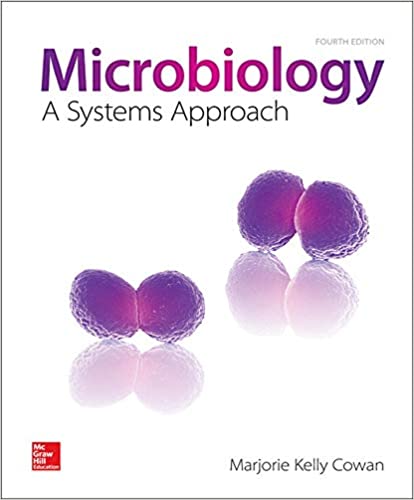
Microbiology: A Systems Approach 4th Edition by Marjorie Kelly Cowan
Edition 4ISBN: 978-0073402437
Microbiology: A Systems Approach 4th Edition by Marjorie Kelly Cowan
Edition 4ISBN: 978-0073402437 Exercise 11
Community-Acquired MRSA in the Big Apple
For decades, methicillin-resistant Staphylococcus aureus (MRSA) has been associated with hospitals. In the hospital setting, there is a higher concentration of infected and compromised patients that require antibiotics and a greater likelihood that microbes exposed to antibiotics will develop resistance through mutation or horizontal gene transfer. Until fairly recently, individuals outside the hospital setting did not have to worry about MRSA. However, in the past several years, reports have emerged of MRSA in the community. Young, healthy athletes, among others, have developed deadly cases of MRSA. Clinicians and researchers have now begun distinguishing between hospital-acquired MRSA (HA-MRSA) and communityacquired MRSA (CA-MRSA).
CA-MRSA usually begins as an innocuous skin infection such as an insect bite, scrape, cut, or pimple and may develop into a more serious deep tissue or bloodstream infection. In a recent study published in the July 2012 issue of Infection Control and Hospital Epidemiology, the number of people admitted to the hospital with CA-MRSA skyrocketed in New York City from 1997 to 2006. In 1997, there were approximately 1.47 admissions to hospitals for CA-MRSA per 100,000 people; in 2006, there were 10.65 admissions per 100,000 people.
What was the cause of the increase in CA-MRSA hospital admissions
What groups are most susceptible to CA-MRSA
The authors of the study speculated that there were several factors that contributed to the increase in CA-MRSA cases in New York City. They found that cases of CAMRSA were higher among patients with diabetes and HIV. Both of these groups tend to have a greater likelihood for open sores or skin lesions, which are the portals of entry for S. aureus. Higher rates of CA-MRSA were seen in the Bronx where residents have more limited access to health care than in the other boroughs of New York. Additionally, higher rates of CA-MRSA were seen among men and children who play contact sports where the possibility of transmission through skin-to-skin contact is higher. Children are also often in daycare settings where there is a high likelihood of disease transmission. According to the study, men, children, individuals with HIV and diabetes, and people who were homeless had the highest rates of CA-MRSA as compared to the general population.

What steps could be taken in New York City and elsewhere to prevent further spread of CA-MRSA
For decades, methicillin-resistant Staphylococcus aureus (MRSA) has been associated with hospitals. In the hospital setting, there is a higher concentration of infected and compromised patients that require antibiotics and a greater likelihood that microbes exposed to antibiotics will develop resistance through mutation or horizontal gene transfer. Until fairly recently, individuals outside the hospital setting did not have to worry about MRSA. However, in the past several years, reports have emerged of MRSA in the community. Young, healthy athletes, among others, have developed deadly cases of MRSA. Clinicians and researchers have now begun distinguishing between hospital-acquired MRSA (HA-MRSA) and communityacquired MRSA (CA-MRSA).
CA-MRSA usually begins as an innocuous skin infection such as an insect bite, scrape, cut, or pimple and may develop into a more serious deep tissue or bloodstream infection. In a recent study published in the July 2012 issue of Infection Control and Hospital Epidemiology, the number of people admitted to the hospital with CA-MRSA skyrocketed in New York City from 1997 to 2006. In 1997, there were approximately 1.47 admissions to hospitals for CA-MRSA per 100,000 people; in 2006, there were 10.65 admissions per 100,000 people.
What was the cause of the increase in CA-MRSA hospital admissions
What groups are most susceptible to CA-MRSA
The authors of the study speculated that there were several factors that contributed to the increase in CA-MRSA cases in New York City. They found that cases of CAMRSA were higher among patients with diabetes and HIV. Both of these groups tend to have a greater likelihood for open sores or skin lesions, which are the portals of entry for S. aureus. Higher rates of CA-MRSA were seen in the Bronx where residents have more limited access to health care than in the other boroughs of New York. Additionally, higher rates of CA-MRSA were seen among men and children who play contact sports where the possibility of transmission through skin-to-skin contact is higher. Children are also often in daycare settings where there is a high likelihood of disease transmission. According to the study, men, children, individuals with HIV and diabetes, and people who were homeless had the highest rates of CA-MRSA as compared to the general population.

What steps could be taken in New York City and elsewhere to prevent further spread of CA-MRSA
Explanation
The number of people admitted to hospita...
Microbiology: A Systems Approach 4th Edition by Marjorie Kelly Cowan
Why don’t you like this exercise?
Other Minimum 8 character and maximum 255 character
Character 255


